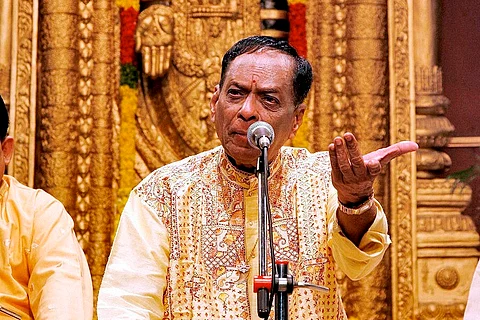

By Ambi Subramaniam
Dr M Balamuralikrishna was a legend and an inspiration to me. Even before I first met him when I was a teenager, I had grown up listening to his music for many years. What I noticed most when I first met him was his jovial and easy-going manner among the greats.
Indeed, for me, the Visions of India project, with my parents collaborating with Balamuraliji, Gangubai Hangalji, Pankaj Udhas, Langas, the Wadali brothers and many others, carried a wonderfully joyous air, almost like children getting together for a party.
Balamuraliji was a great artist, who highlighted the importance of fundamentals of classical music like voice production, diction and excellent pitching, which made his music accessible to everyone without compromising on the quality of compositions and performances.
When you see a musician of the calibre of Balamuraliji, it’s easy to miss how difficult the path of an innovator is, and the immensity of what he had to go through because he refused to conform.
But what defined the maestro was that he never caved in to that pressure, and never shied away from doing what he believed was right. Balamuraliji was a true innovator in every sense of the term – he never felt the need to be answerable to someone else’s perception of the right way. If he felt that he wanted to take his music in a particular direction, he plunged headlong down that road, without a care for popular opinion.
He was never one to refrain from experimentation, and hence remained a truly path-breaking artiste through his career.
The only time I have ever played the role of an accompanist, was when I played for him during the ‘Visions of India’ tour in 2007. It was a first for me, and naturally, I was nervous. During that tour, there was one small change he made, which showed clearly his openness to moving away from tradition when he felt it necessary.
Recognising that the show might be better received if performed standing up, rather than sitting on the floor of the stage, he chose to do away with the traditional seated arrangement. And he told me, “You’re also comfortable standing up and playing. Come, let us both perform Carnatic music standing instead of sitting.” What touched me was that he not only moved away from the rule for what he felt better suited the time and place of the person, but also that he included me in the gesture, never letting me feel like an accompanist.
During that tour, we played the same piece three times in three different concerts. But each time he produced a radically different interpretation of the piece, improvising on different lines and giving me a great and wonderful challenge to match him.
I had a sense of his view of performance from listening to him for so many years and playing with him only confirmed it – he liked being challenged on stage. He sang for himself, shifting through levels of complexity from concert to concert based on what worked best for the situation, the accompaniment and so on.
He was childlike and playful on stage – almost as if he were throwing out a challenge to me, and he was delighted when I returned a phrase, only for him to pick up where I left off. He even started singing in different nadais and rhythmical patterns because he knew that was a trademark of my father’s style, something I didn’t normally hear him do in recordings.
I remember another special concert that I was a part of – featuring Balamuraliji, Hariji on the flute and my father on the violin. During Balamuraliji’s solo segment, he picked up one of his own compositions in one of his raagas (Lavangi) – one that used only four notes. Over the next half an hour he sang some of the most amazing phrases I have heard, using only four notes, each phrase drawing his listeners further in than the one before. It was a stupendous display of creativity and innovation, and in a way it was him at his best, because it was a powerful challenge to himself!
Balamuraliji was very flexible and confident in his own abilities, which made him an easy collaborator for many different artists. He would sing in different pitches to match the different instruments accompanying him. I remember an anecdote of one of his collaborations with a great flautist, where the flautist asked if he could sing in the key of D for that concert. Balamuraliji said anything from C to G is fine. That is unheard of for an instrumentalist, leave alone a classical vocalist.
On stage and off, Balamuraliji was a great inspiration. Soon after I had performed with him, he once came to our house with two large volumes of music and said, “Here are all my compositions. I want you to play them.”
Besides his singing, his innovations as a composer were amazing, and without a doubt, his compositions will stay with us for many generations.
My favourite piece among all of his is one of his "ragamalikatillanas” in “amritavarshini” and “hindolam” raagas.
Since he was an accomplished viola player as well, the composition is deceptively difficult for a violinist. This was possibly one of the reasons playing with him was especially challenging for a violinist – as a superlative string player himself, he knew just how to challenge the violinists who accompanied him.
Balamuraliji may have left us, but there is no doubt in my mind that his voice and his music will remain with us for years to come, haunting us with the sheer joy of a musician who led us down new and beautiful musical paths.
(Ambi Subramaniam is the son of violin maestro Dr L Subramaniam, and a renowned classical and fusion violinist and composer in his own right. Read more about him here.)